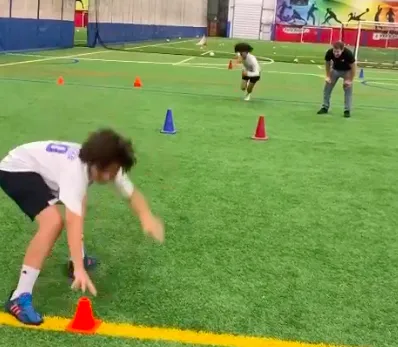ATHLETE BLOG LEOMINSTER

4 Reasons To Be Concerned With Poor Ankle Flexibility
Creators Lee Burton and Gray Cook developed the 7 drill Functional Movement Screen in 1997.
Its first use was in a sports medicine clinic, to help improve athletic performance while reducing injury risk.
Since then, it has caught on with professional and college sports teams worldwide.
They did not see fit to change anything about the screen for nearly 25 years, which speaks to the quality of the original tests.
So when they recently added an 8th screen, performance coaches knew right away it was measuring something important.
That something is ankle flexibility.
The original 7 focus on core stability, shoulder movement, balance and hip flexibility.
Their data showed that there was another major movement issue that was limiting performance, and causing injury, which the other 7 screens weren't capturing.
How right they were.
As we use the FMS system to create custom workouts for all our athletes, I can tell you just how common poor ankle flexibility is.
Walk into the beginning of our youth group personal training classes any day of the week and you'll observe a sea of ankle mobility drills being executed.
I'd say more than 50% of the middle and high school athletes we see have a limitation on their first day.
Of course, not a single one of them cares about ankle flexibility!
But they do want to run faster, lift more weights, and stay injury free.
So what's the connection?
Poor Ankle Mobility Interferes with Sprint Mechanics
Elite sprinters don't run with their toes turned out.
Tightness in the muscles below the knee often cause a 'duck toed' position.
That causes problems when sprinting because you'll strike the ground with more of the outside edge of your foot, which causes you to roll in before pushing off the ground.
This is inefficient, slowing you down by causing you to spend too much time on the ground.
A more forward facing foot strike allows you to pop off the ground quickly, with the split seconds saved on each stride adding up to make you noticeably faster.
Poor Ankle Mobility Causes Slower Changes of Direction
Much like sprinting is done best when your foot strikes the ground a certain way, the same goes for changes of direction.
Athletes who play faster than their stopwatch times do so in part by learning how to accelerate out of their cuts.
Driving off the entire inside edge of your foot on a cut allows you to re-accelerate almost immediately.
Limited ankle flexibility causes more of a toes only push.
Which is like throwing a punch with one finger instead of a full fist.
You won't get a lot of power out of it, and it will slow down your game.
Poor Ankle Mobility Leads to More Weight Room Injuries
Squatting, deadlifting, lunging and jumping requires a good amount of bend at the hips, knees and ankles.
The three joints work together.
If one isn't doing its job, much like a group project in school or at work, then the others must pick up the slack.
Too much motion at the hips leads to back pain and/or hamstring pulls.
Too much motion at the knee leads to patella tendonitis.
Your ankles should freely bend to allow your knees to move about 6" in front of your toes while keeping your heels down.
Anything less and it is impacting your lifting form.
Poor Ankle Mobility Leads to More Ankle & Knee Sprains
Tightness in the ankle joint almost always happens on the outside of your lower leg.
Because of this, when you run and plant your foot to cut your knee will be more likely to buckle in towards your other leg.
That's how ACL tears happen.
But it is also how you sprain your ankle, as any plant step that puts too much weight on the outside edge of your foot can cause it to roll rapidly.
Both are potentially season ending injuries.
Now, even with all this in mind, I'm sure no athlete will walk into their next workout pumped up to build their ankle flexibility.
Hopefully, though, this now puts into better perspective why it is so critical to athletic performance, and why we spend so much time working on it here at our facility.
Power Source Reviews
© Copyright 2024. Power Source. All rights reserved.
|
